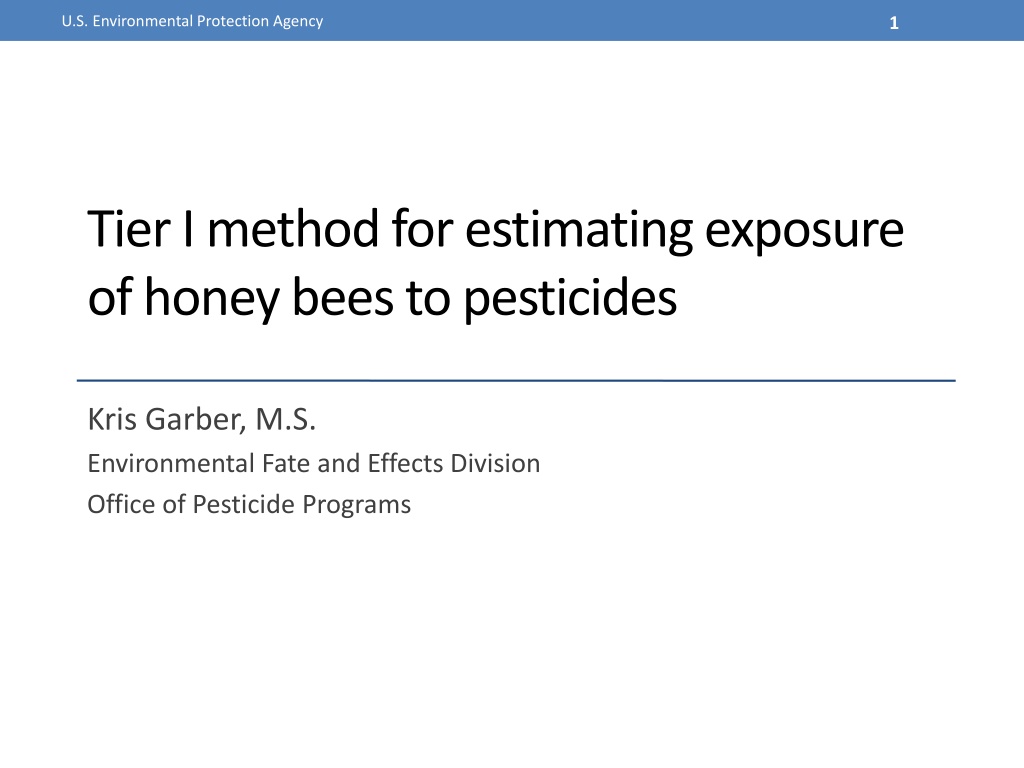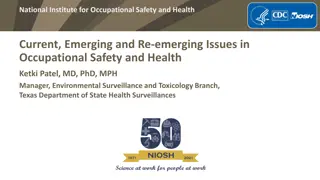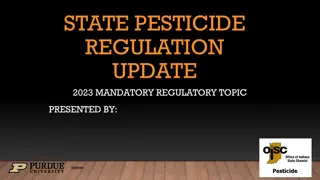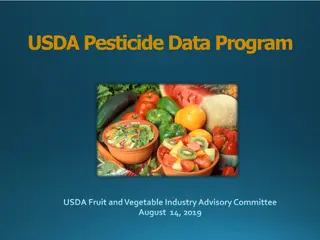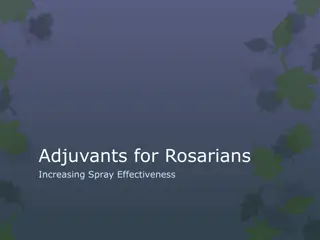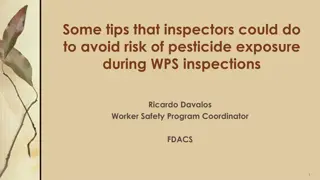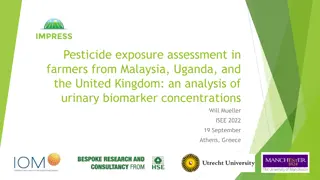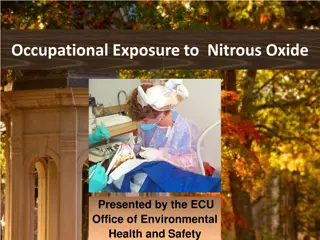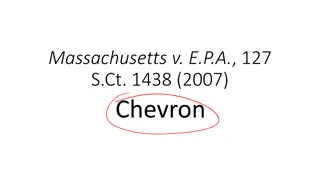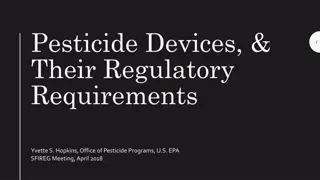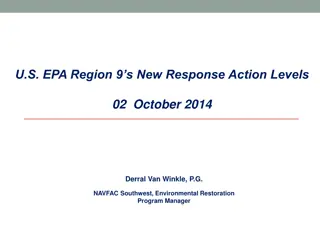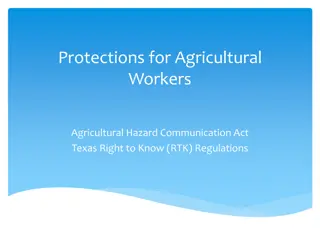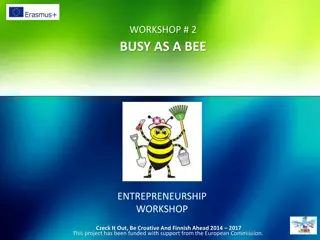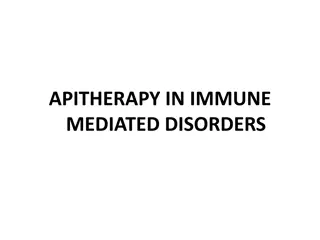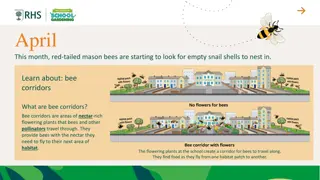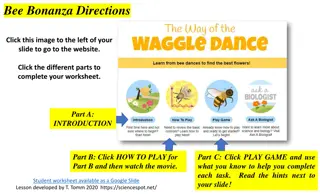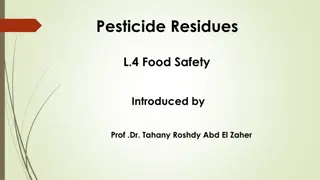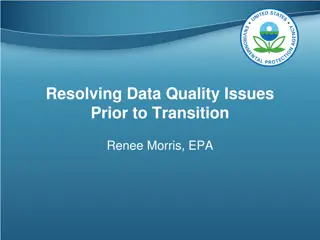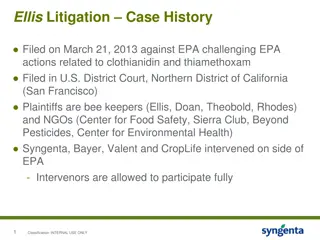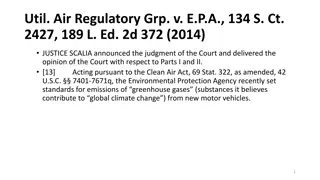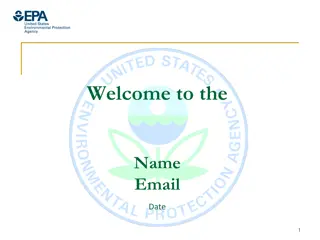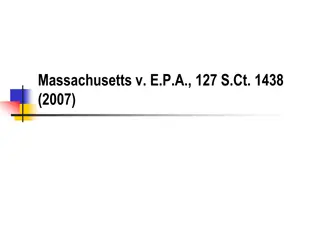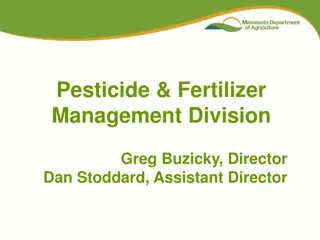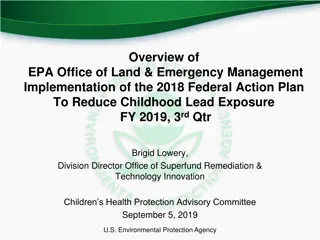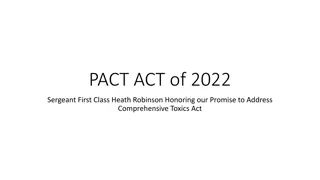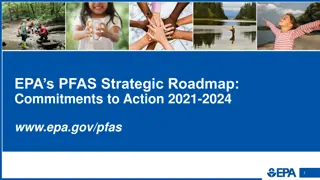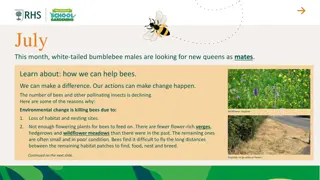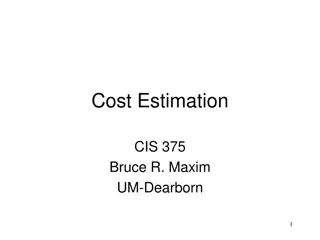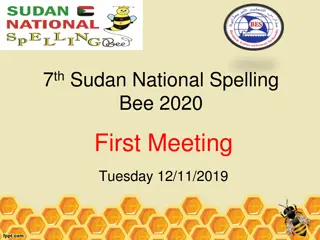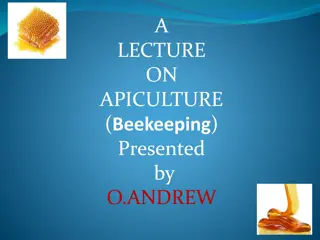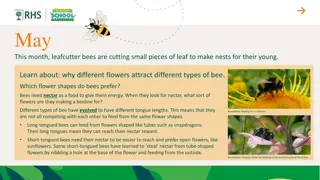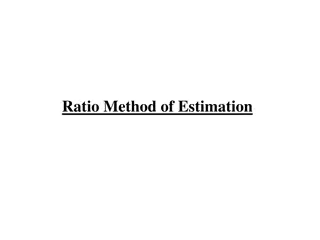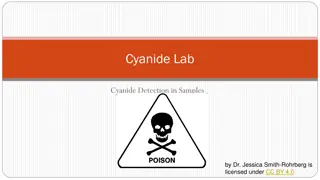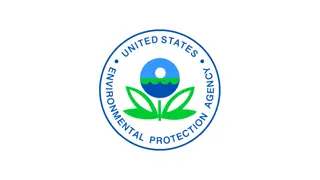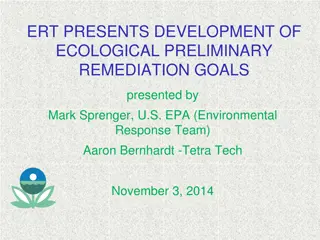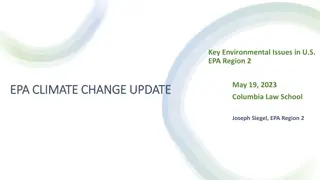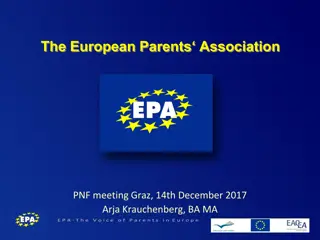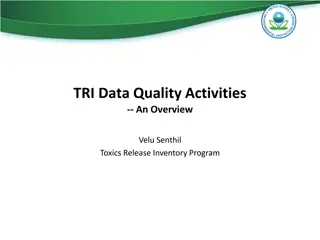U.S. EPA Tier I Method for Bee Pesticide Exposure Estimation
Tier I assessment by the U.S. Environmental Protection Agency focuses on generating conservative estimates of pesticide exposures to honey bees. The goal is to differentiate pesticides that pose risks to bees from those needing further evaluation. The process involves considering food consumption rates, exposure scenarios, and calculating screening-level risk quotients. This approach helps identify potential effects even in cases where none are observed, minimizing Type II errors. Decision trees outline steps for foliar spray, seed, and soil treatments to assess exposure concerns for adult bees and brood.
Download Presentation

Please find below an Image/Link to download the presentation.
The content on the website is provided AS IS for your information and personal use only. It may not be sold, licensed, or shared on other websites without obtaining consent from the author. Download presentation by click this link. If you encounter any issues during the download, it is possible that the publisher has removed the file from their server.
E N D
Presentation Transcript
U.S. Environmental Protection Agency 1 Tier I method for estimating exposure of honey bees to pesticides Kris Garber, M.S. Environmental Fate and Effects Division Office of Pesticide Programs
2 U.S. Environmental Protection Agency Outline Overview of Tier I exposure assessment Food Consumption What do honey bees eat? Proposed food consumption rates for larval and adult workers Discussion of conservativeness of proposed consumption rates Estimating Exposures for Tier I assessment Foliar Spray Applications Seed Treatments Soil Applications
3 U.S. Environmental Protection Agency Overview of Tier I exposure assessment
4 U.S. Environmental Protection Agency Purpose of Tier I Exposure Assessment The goal is to generate reasonably conservative estimates of pesticide exposures to bees Intended to distinguish between: Pesticides that do not pose a risk to bees and those that may need additional information Type I and II Errors Tier I assessment should not conclude that there is no effect when there actually is (Type II) It is more acceptable at the Tier I level to conclude that there is a potential effect when there is none (Type I)
5 U.S. Environmental Protection Agency Tier I exposure assessment component of decision tree for foliar spray applications. Yes No 1. Details of the product and its use pattern Presumption of minimal No Tier 1 brood assessment 2a. Is exposure of adult bees a concern? 2b. Is exposure of bee brood a concern? risk Oral Exposure Contact Exposure Oral Exposure 3a. Calculate Tier 1 screening-level EEC for adult contact exposure 3b. Calculate Tier 1 screening- level EEC for adult oral exposure via pollen and nectar 3c. Calculate Tier 1 screening-level EEC for larval oral exposure via brood food 4c. Calculate Tier 1 screening-level RQs for larval oral exposure (RQ = EEC/larval acute LD50 & RQ= EEC/larval chronic NOAEC)* 4b. Calculate Tier 1 screening- level RQs for adult oral exposure (RQ = EEC/adult acute oral LD50 & RQ = EEC/adult chronic NOAEC)* 4a. Calculate Tier 1 screening-level RQs for adult contact exposure (RQ = EEC/adult acute contact LD50)
6 U.S. Environmental Protection Agency Tier I exposure assessment component of decision tree for seed and soil treatments. Yes No 1. Details of the product and its use pattern Presumption of minimal No Tier 1 brood assessment 2a. Is exposure of adult bees a concern? 2b. Is exposure of bee brood a concern? risk Oral Exposure Oral Exposure 3a. Calculate Tier 1 screening- level EEC for adult oral exposure via pollen and nectar 3b. Calculate Tier 1 screening-level EEC for larval oral exposure via brood food 4b. Calculate Tier 1 screening-level RQs for larval oral exposure (RQ = EEC/larval acute LD50 & RQ= EEC/larval chronic NOAEC)* 4a. Calculate Tier 1 screening- level RQs for adult oral exposure (RQ = EEC/adult acute oral LD50 & RQ = EEC/adult chronic NOAEC)*
7 U.S. Environmental Protection Agency Food consumption of honey bees
8 U.S. Environmental Protection Agency Honey bee diet What do honey bees eat? Pollen Bee bread Nectar Honey Jelly Royal Jelly Brood Food Food consumption varies By caste By age
9 U.S. Environmental Protection Agency Proposed food consumption rates for Tier I exposure assessment Adult honey bees = 292 mg food/day Based on nectar foraging worker Represents consumption of nectar Pollen consumption is insignificant relative to nectar Larvae = 120 mg food/day Based on 5 day old worker larvae Represents consumption of honey (converted to nectar equivalent) and pollen
10 U.S. Environmental Protection Agency Assumptions for Tier I Exposure Assessment (related to Food Consumption) Pesticide does not dissipate while stored in the hive Pesticide concentrations in pollen and bee bread are equivalent Pesticide concentrations in nectar can be used to represent concentrations in honey Honey consumption rate can be converted to a nectar equivalent basis Using sugar consumption rates and sugar contents of honey and nectar Pesticide doses will be eqivalent Pesticide doses received from pollen and nectar are protective of doses from jelly Available data indicate that pesticides are 100x greater in food of nurse bees compared to royal jelly Pesticide concentration in foliage = conc. in nectar = conc. in pollen
11 U.S. Environmental Protection Agency Proposed food consumption rate: Adult Worker Bees Food Consumption rates for adult worker bees Nectar: Rortais et al. (2005) Pollen: Crailsheim et al (1992) Nectar forager bees have highest food consumption rates Consumption rate (mg/day) Pollen Nectar 2.2-8.2 60 1.7-9.5 113-167 Adult worker task Age (d) Total food 62-68 115-177 Cell cleaning and capping Brood and queen attending Comb building, cleaning and food handling Forager (pollen) Forager (nectar) 0-10 6-17 11-18 1.7 60 62 >18 >18 0.041 0.041 35-52 107-428 35-52 107-428
12 U.S. Environmental Protection Agency Proposed food consumption rate: Adult Worker Bees = 292 mg/day Proposed value is estimated using modification to Rortais et al. s method 100% 90% 80% 70% Percentile Monte Carlo Simulation of 5 variables Sugar required for flying Number of foraging trips made in a day Duration of foraging trip Fraction of time spent flying during trip Amount of sugar present in nectar 60% 50% 40% 30% 20% 10% 0% 0 200 400 600 800 Nectar consumption (mg/day) Analysis also included sugar requirements while resting Proposed value is median of 10,000 simulated bees
13 U.S. Environmental Protection Agency Nectar and pollen consumption rates of adult worker bees by task and drones. 300 Pollen Nectar 250 Food consumption (mg/day) 200 150 100 50 0 Worker (cell cleaning and capping) Worker (brood and queen tending, nurse bees) Worker (comb building, cleaning and food handling) Worker (foraging for pollen) Caste (task) Worker (foraging for nectar) Worker (maintenance of hive in winter) Drone
14 U.S. Environmental Protection Agency Honey and pollen consumption rates of adult worker bees by task and drones. 300 Pollen Honey 250 Food consumption (mg/day) 200 150 100 50 0 Worker (cell cleaning and capping) Worker (brood and queen tending, nurse bees) Worker (comb building, cleaning and food handling) Worker (foraging for pollen) Caste (task) Worker (foraging for nectar) Worker (maintenance of hive in winter) Drone
15 U.S. Environmental Protection Agency Comparison of proposed food consumption rates (mg/day) to non-Apis bees: Adults Species Nectar Pollen Total food Honey bee worker (Apis mellifera) Bumblebee (Bombus spp.) European mason bee (Osmia cornuta) Alfalfa leaf-cutting bee (Megachile rotundata) 292 0.04 292 183-372 27-30 210-402 45-193 na 45-193 110-165 na 110-165
16 U.S. Environmental Protection Agency Proposed food consumption rate: Larval Worker Bees It is assumed that larvae grow exponentially and that their daily food consumption rate doubles every day Consume 120 mg total food during days 4 and 5 5.4 mg pollen 115 mg honey (diluted to 45% sugar; Rortais et al. 2005) Daily food consumption rate (mg/day) Brood food / royal jelly 3.8 none Day of life stage Honey Pollen Total food 1 none 3.8 2 7.5 none none 7.5 3 15 none none 15 4 none 37 2.7 40 5 none 77 2.7 80
17 U.S. Environmental Protection Agency Proposed food consumption rate: Larval Worker Bees Proposed value of 120 mg/day is based on 5th day of life stage Highest food consumption value compared to other days of larval life stage Consumption of 2.7 mg pollen Honey consumption rate is converted to nectar equivalent rate (117 mg/day)
18 U.S. Environmental Protection Agency Honey, pollen and brood food or royal jelly consumption rates of larvae of different castes and ages. 300 Royal jelly/brood food Pollen Honey 250 Food consumption (mg/day) 200 150 100 50 0 Worker (1) Worker (2) Worker (3) Worker (4) Worker (5) Drone (5) Drone (6) Queen (1) Queen (2) Queen (3) Queen (4) Queen (5) Caste (day of life stage)
19 U.S. Environmental Protection Agency Honey, pollen and brood food or royal jelly consumption rates of larvae of different castes and ages. 300 Royal jelly/brood food 250 Food consumption (mg/day) 200 150 100 50 0 Worker (1) Worker (2) Worker (3) Worker (4) Worker (5) Drone (5) Drone (6) Queen (1) Queen (2) Queen (3) Queen (4) Queen (5) Caste (day of life stage)
20 U.S. Environmental Protection Agency Honey, pollen and brood food or royal jelly consumption rates of larvae of different castes and ages. 300 Royal jelly/brood food Pollen Honey 250 Food consumption (mg/day) 200 150 100 50 0 Worker (1) Worker (2) Worker (3) Worker (4) Worker (5) Drone (5) Drone (6) Queen (1) Queen (2) Queen (3) Queen (4) Queen (5) Caste (day of life stage)
21 U.S. Environmental Protection Agency Nectar, pollen and brood food or royal jelly consumption rates of larvae of different castes and ages. 300 Royal jelly/brood food Pollen Nectar 250 Food consumption (mg/day) 200 150 100 50 0 Worker (1) Worker (2) Worker (3) Worker (4) Worker (5) Drone (5) Drone (6) Queen (1) Queen (2) Queen (3) Queen (4) Queen (5) Caste (day of life stage)
22 U.S. Environmental Protection Agency Pesticide doses received by larvae of different castes and ages through consumption of pollen and nectar containing 100 g a.i./kg and royal jelly containing 1 g a.i./kg. Royal jelly/brood food Pollen Nectar 14 12 Pesticide dose ( g a.i./bee) 10 8 6 4 2 0 Worker (1) Worker (2) Worker (3) Worker (4) Worker (5) Drone (5) Drone (6) Queen (1) Queen (2) Queen (3) Queen (4) Queen (5) Caste (day of life stage)
23 U.S. Environmental Protection Agency Comparison of proposed food consumption rates (mg/day) to non-Apis bees: Larvae Species Male/ female Nectar Pollen Total food Honey bee (Apis mellifera) Bumblebee (Bombus spp.) European mason bee (Osmia cornuta) Alfalfa leaf-cutting bee (Megachile rotundata) Female 117 2.7 120 unknown 60 22-23 82-83 Female Male Female Male 1.8 1.1 6.2 5.2 16.3 9.5 3.1 2.6 18 11 9.3 7.8
24 U.S. Environmental Protection Agency Summary of Food Consumption Analysis Assume that pesticide doses received through consumption of pollen and nectar can be used to conservatively represent other types of food Proposed food consumption rates Adults = 292 mg/day (nectar forager) Larvae = 120 mg/day (5 day old) Appear to be protective for other honey bees and some non-Apis bees Interested in SAP comments on proposed food consumption rates, related assumptions, strengths and limitations Charge question 5 Interested in SAP comments on relative protectiveness of proposed food consumption rates in representing exposures to non-Apis bees Charge question 3
25 U.S. Environmental Protection Agency Tier I methods for estimating pesticide concentrations on bees and in pollen and nectar
26 U.S. Environmental Protection Agency Estimating pesticide exposures for Tier I assessment Foliar applications Contact EEC- Koch and Weisser 1997 Dietary EEC- T-REX tall grass upper bound Seed treatments Dietary EEC - EPPO default value of 1 mg a.i./kg Soil treatments Dietary EEC - Modified Briggs Model All dietary EECs converted to a dose using proposed food consumption rates for adult (292 mg/day) and larval (120 mg/day) workers
27 U.S. Environmental Protection Agency Identification and Evaluation of Methods Methods considered Many are currently used for regulatory purposes Other methods available in the open literature Evaluation of Methods Compared to empirical data from scientific literature and unpublished registrant studies Amount of data available to evaluate each method varied Application type (route) Method Number of studies Foliar spray (contact) Foliar spray (diet) Seed treatment (diet) Soil treatment (diet) Koch and Weisser T-REX (tall grass) EPPO (1 mg/kg) Briggs Model 2 11 12 6
28 U.S. Environmental Protection Agency Estimating Contact Exposures for Foliar Spray Applications Description of Proposed Method Contact Dose = 2.7 g a.i./bee * Application rate (in lb a.i./A) From Koch and Weisser (1997) Based on maximum concentration of chemical tracer measured on bees foraging on treated areas 5 trials on Phacelia fields (total number of bees analyzed = 1724) 9 trials on apple orchards (total number of bees analyzed = 4316)
29 U.S. Environmental Protection Agency Estimating Contact Exposures for Foliar Spray Applications Frequency distribution of measured tracer on individual bees during 5 trials with Phacelia fields. 100 43% of bees Trial 1 90 80 Percent of bees in trial Trial 2 70 60 Trial 3 50 40 Trial 4 30 20 Trial 5 10 0 <=0.26 >0.26 to >0.53 to <=0.79 >0.79 to <=1.1 >1.1 to <=1.3 >1.3 to <=1.6 >1.6 to <=1.8 >1.8 to <=2.1 >2.1 to <=2.4 >2.4 <=0.53 Mass of tracer measured on individual bees ( g a.i./bee per 1 lb/A)
30 U.S. Environmental Protection Agency Estimating Contact Exposures for Foliar Spray Applications Frequency distribution of measured tracer on individual bees during 9 trials with apple orchards. 71% of bees 100 Trial 1 90 Trial 2 80 Percent of bees in trial Trial 3 70 Trial 4 60 Trial 5 50 Trial 6 40 Trial 7 30 Trial 8 20 Trial 9 10 0 <=0.26 >0.26 to >0.53 to <=0.79 >0.79 to <=1.1 >1.1 to <=1.3 >1.3 to <=1.6 >1.6 to <=1.8 >1.8 to <=2.1 >2.1 to <=2.4 >2.4 <=0.53 Mass of tracer measured on individual bees ( g a.i./bee per 1 lb/A)
31 U.S. Environmental Protection Agency Estimating Contact Exposures for Foliar Spray Applications Discussion of Relevance of T-REX arthropod residue value Contact Dose = 12 g a.i./bee * Application rate (in lb a.i./A) Value represents 95th percentile residue value (94 mg a.i./kg) converted to a dose using weight of a bee (0.128 g) Based on analysis of pesticide residues on crickets, grasshoppers, beetles, etc. located on treated field at the time of the application Limitation: data set does not include residue data for honey bees
32 U.S. Environmental Protection Agency Estimating Contact Exposures for Foliar Spray Applications Method Evaluation No upper bound residues available to evaluate proposed value Mean Koch and Weisser (1997) data and T-REX arthropod residue values are consistent with means of empirical data from 2 other studies 9 ( g a.i./bee per 1 lb a.i./A) 8 Mean contact dose 7 6 5 4 3 2 1 0 T-REX Koch and Weisser 1997 (Phacelia) Koch and Weisser 1997 (apple) Delabie et al. 1985 Hanny and Harvey 1982 Hanny and Harvey 1982 (arthropod) Source
33 U.S. Environmental Protection Agency Estimating Contact Exposures for Foliar Spray Applications Assumptions and Uncertainties Limited number of studies available for evaluation of method Based on only two crops Based on one study site Strengths of proposed method Koch and Weisser (1997) maximum value appears to be conservative Robust study design Maximum value is based on measurements of >6000 bees Tracer did not impact study results Consistent with other methods that are empirically based T-REX arthropod residue value (factor of 5 different) Atkins et al. 1981
34 U.S. Environmental Protection Agency Estimating Dietary Exposures for Foliar Spray Applications Description of Proposed Method Use T-REX upper bound residue value on foliage as a surrogate for pollen and nectar Sufficient data are not available to derive nectar or pollen specific residue values Concentration (mg a.i./kg per 1 lb a.i./A) Plant Description Upper-bound Mean Short grass 240 85 Broadleaf plants 135 45 Tall grass 110 36 Fruit, pods and seeds 15 7
35 U.S. Environmental Protection Agency Estimating Dietary Exposures for Foliar Spray Applications Method Evaluation: mean empirical data for nectar (n = 10) Mean residues for short grass, broad leaf plants and tall grass are all higher than mean empirical data 4 empirical values exceed the mean residue for fruit, pods and seeds Maximum residues only available for some studies (0.17-2.2 mg a.i./kg per 1 lb a.i./A) 100 90 (mg a.i./kg per 1 lb a.i./A) Short grass 80 mean concentration 70 60 50 Broadleaf 40 Tall grass 30 20 10 Fruit, etc. 0 chemical
36 U.S. Environmental Protection Agency Estimating Dietary Exposures for Foliar Spray Applications Method Evaluation: mean empirical data for pollen (n = 9) Mean residue for short grass is higher than mean empirical data Mean residues for broad leaf plants and tall grass higher than all but one residue value 5 empirical values exceed the mean residue for fruit, pods and seeds 100 90 (mg a.i./kg per 1 lb a.i./A) Short grass 80 mean concentration 70 60 50 Broadleaf Tall grass 40 30 20 10 Fruit, etc. 0 chemical
37 U.S. Environmental Protection Agency Estimating Dietary Exposures for Foliar Spray Applications Method Evaluation: maximum empirical data for pollen (n = 14) Upper bound residues for short grass, broadleaf plants and tall grass are higher than empirical data 7 empirical values exceed the mean residue for fruit, pods and seeds 250 (mg a.i./kg per 1 lb a.i./A) Short grass Max concentration 200 150 Broadleaf Tall grass 100 50 Fruit, etc. 0 chemical
38 U.S. Environmental Protection Agency Estimating Dietary Exposures for Foliar Spray Applications Summary of Evaluation and Proposed Method Short grass, broad leaf plant and tall grass residues are consistently conservative relative to mean and maximum residue data for pollen and nectar Only one value exceeds tall grass and broad leaf plant residues Tall grass value is closest to empirical data Proposed residue concentration is 110 mg a.i./kg per 1 lb a.i./A Adult dose: 32 g a.i./bee per 1 lb a.i./A Larval dose: 13 g a.i./bee per 1 lb a.i./A
39 U.S. Environmental Protection Agency Estimating Dietary Exposures for Foliar Spray Applications Assumptions and Uncertainties Assume that tall grass upper bound is representative of pollen and nectar Assume that concentration from direct foliar spray at time of application exceeds later concentration resulting from systemic transport Strengths of proposed method Tall grass upper bound concentration appears to be reasonably conservative compared to empirical concentrations on pollen and nectar
40 U.S. Environmental Protection Agency Estimating Dietary Exposures for Seed Treatments Description of Proposed Method Assume that pesticide concentration in pollen and nectar of seed treated crops is 1 mg a.i./kg (1 g a.i./g) No adjustment is made for application rate Based on EPPO s recommended screening value Final doses calculated by multiplying 1 g a.i./g by food intake rates Adult Dose = 0.29 g a.i./bee Larval Dose = 0.12 g a.i./bee
41 U.S. Environmental Protection Agency Estimating Dietary Exposures for Seed Treatments Method Evaluation: empirical data for pollen (n = 18) 1 mg a.i./kg screen is factor of 28 above highest concentration 1 Concentration (mg a.i./kg) 0.1 < 0.01 < < 0.001 < 0.0001 Chemical
42 U.S. Environmental Protection Agency Estimating Dietary Exposures for Seed Treatments Method Evaluation: empirical data for nectar (n = 6) 1 mg a.i./kg screen is 3 orders of magnitude above empirical data 1 Concentration (mg a.i./kg) 0.1 < 0.01 < 0.001 < 0.0001 Clothianidin Clothianidin Imidacloprid Imidacloprid Thiamethoxam Unnamed Chem # 2 Chemical
43 U.S. Environmental Protection Agency Estimating Dietary Exposures for Seed Treatments Assumptions and Uncertainties Assumed that pesticides applied to seeds are systemically transported Does not account for application rate Does not account for fate of pesticide Strengths of proposed method 1 mg a.i./kg value is conservative relative to empirical data By a factor of 28 for pollen By a factor of 333 for nectar
44 U.S. Environmental Protection Agency Estimating Dietary Exposures for Soil Applications Description of Proposed Method Based on Briggs model (Briggs et al. 1982, 1983) Predicts concentration in stems using: Octanol-water partition coefficient (Kow) Concentration in water (Cwater) Transpiration Stream Concentration Factor (TSCF) Calculated using Kow 10 . 2 = + . 0 ( 95 * 05 ) LogKow * . 0 82 * C TSCF C stem water
45 U.S. Environmental Protection Agency Estimating Dietary Exposures for Soil Applications Description of Proposed Method (continued) Includes soil water partitioning as proposed by Ryan et al. (1988) Requires organic-carbon partition coefficient (Koc) or soil partition coefficient (Kd) Requires concentration in soil (Csoil) instead of Cwater Requires basic soil properties Soil bulk density ( ) Soil water content ( ) Fraction of organic carbon (foc) 10 = + . 0 ( 95 * . 2 05 ) LogKow * . 0 82 * * C TSCF C + * * Koc foc stem soil
46 U.S. Environmental Protection Agency Estimating Dietary Exposures for Soil Applications Description of Proposed Method (continued) Modifications to the TSCF calculation were made by EPA to generate more conservative estimates of the concentration in stems (Appendix 5) Estimates of median and 95th percentile TSCF values based on empirical dataset reported by Briggs et al. 1982. 1 Median TSCF 95th percentile TSCF 0.8 0.6 TSCF 0.4 0.2 0 -1 0 1 2 3 4 5 Log Kow
47 U.S. Environmental Protection Agency Estimating Dietary Exposures for Soil Applications Method Evaluation: empirical data for pollen (n = 14) Model predictions are generally conservative compared to empirical data Concentration (mg a.i./kg per 1 lb a.i./A) 2 1.8 1.6 1.4 1.2 1 0.8 0.6 0.4 0.2 0 Chemical
48 U.S. Environmental Protection Agency Estimating Dietary Exposures for Soil Applications Method Evaluation: empirical data for nectar (n = 16) Model predictions are generally conservative compared to empirical data Concentration (mg a.i./kg per 1 lb a.i./A) 2 1.8 1.6 1.4 1.2 1 0.8 0.6 0.4 0.2 0 Chemical
49 U.S. Environmental Protection Agency Estimating Dietary Exposures for Soil Applications Consideration of EPPO s 1 mg a.i./kg screen Conservative for all but one value from empirical data set Dimethoate concentration in nectar (4.82 mg a.i./kg; Lord et al. 1968) High application rate (17 lb a.i./A) Does not account for application rate Does not account for fate of chemical
50 U.S. Environmental Protection Agency Estimating Dietary Exposures for Soil Applications Assumptions and Uncertainties of modified Briggs Model Uses stem concentrations as surrogates for pollen and nectar Assumed that pesticides applied to soil are systemically transported Data from barley only Limited number and type of chemicals (2 classes of non-ionic pesticides) May have limited application to ionic chemicals Xylem based Strengths of proposed method Estimates appear to be reasonably conservative Accounts for some basic chemical specific parameters Application rate Kow Koc (or Kd)
